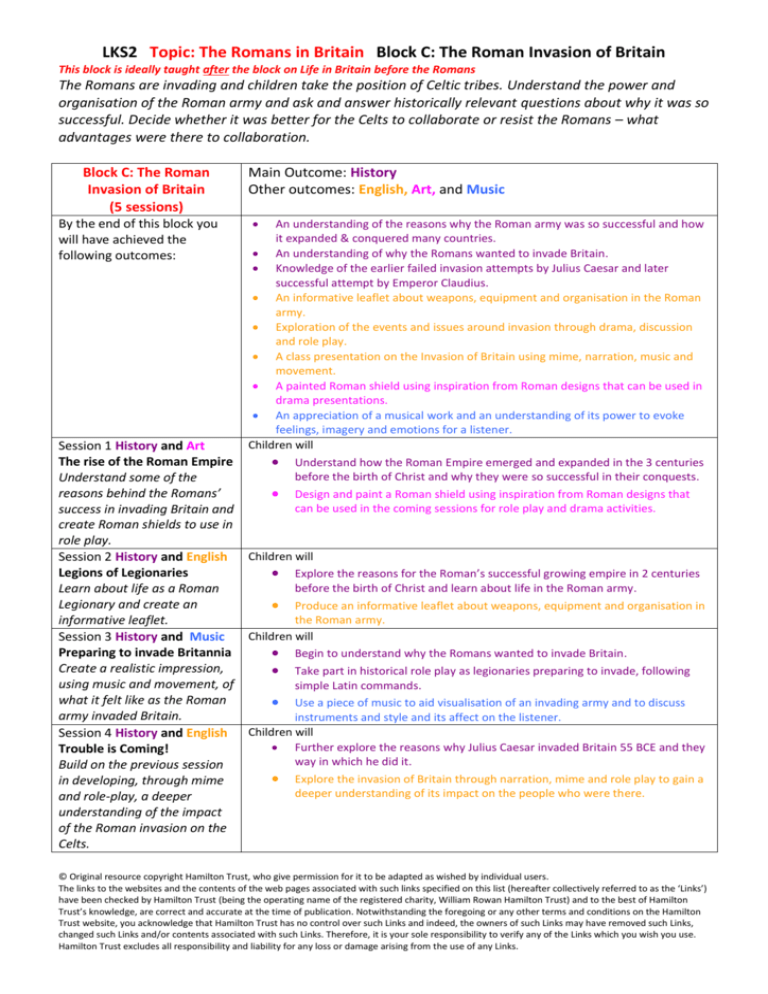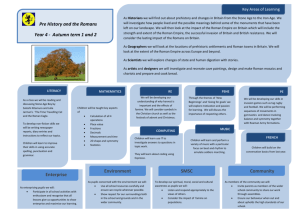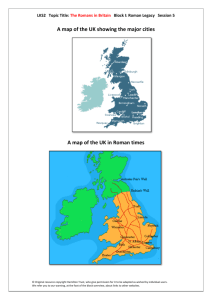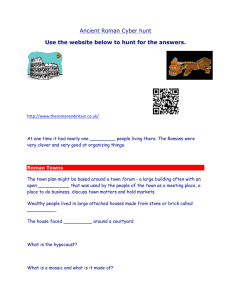Block Outcomes - Hamilton Trust
advertisement

LKS2 Topic: The Romans in Britain Block C: The Roman Invasion of Britain This block is ideally taught after the block on Life in Britain before the Romans The Romans are invading and children take the position of Celtic tribes. Understand the power and organisation of the Roman army and ask and answer historically relevant questions about why it was so successful. Decide whether it was better for the Celts to collaborate or resist the Romans – what advantages were there to collaboration. Block C: The Roman Invasion of Britain (5 sessions) By the end of this block you will have achieved the following outcomes: Session 1 History and Art The rise of the Roman Empire Understand some of the reasons behind the Romans’ success in invading Britain and create Roman shields to use in role play. Session 2 History and English Legions of Legionaries Learn about life as a Roman Legionary and create an informative leaflet. Session 3 History and Music Preparing to invade Britannia Create a realistic impression, using music and movement, of what it felt like as the Roman army invaded Britain. Session 4 History and English Trouble is Coming! Build on the previous session in developing, through mime and role-play, a deeper understanding of the impact of the Roman invasion on the Celts. Main Outcome: History Other outcomes: English, Art, and Music An understanding of the reasons why the Roman army was so successful and how it expanded & conquered many countries. An understanding of why the Romans wanted to invade Britain. Knowledge of the earlier failed invasion attempts by Julius Caesar and later successful attempt by Emperor Claudius. An informative leaflet about weapons, equipment and organisation in the Roman army. Exploration of the events and issues around invasion through drama, discussion and role play. A class presentation on the Invasion of Britain using mime, narration, music and movement. A painted Roman shield using inspiration from Roman designs that can be used in drama presentations. An appreciation of a musical work and an understanding of its power to evoke feelings, imagery and emotions for a listener. Children will Understand how the Roman Empire emerged and expanded in the 3 centuries before the birth of Christ and why they were so successful in their conquests. Design and paint a Roman shield using inspiration from Roman designs that can be used in the coming sessions for role play and drama activities. Children will Explore the reasons for the Roman’s successful growing empire in 2 centuries before the birth of Christ and learn about life in the Roman army. Produce an informative leaflet about weapons, equipment and organisation in the Roman army. Children will Begin to understand why the Romans wanted to invade Britain. Take part in historical role play as legionaries preparing to invade, following simple Latin commands. Use a piece of music to aid visualisation of an invading army and to discuss instruments and style and its affect on the listener. Children will Further explore the reasons why Julius Caesar invaded Britain 55 BCE and they way in which he did it. Explore the invasion of Britain through narration, mime and role play to gain a deeper understanding of its impact on the people who were there. © Original resource copyright Hamilton Trust, who give permission for it to be adapted as wished by individual users. The links to the websites and the contents of the web pages associated with such links specified on this list (hereafter collectively referred to as the ‘Links’) have been checked by Hamilton Trust (being the operating name of the registered charity, William Rowan Hamilton Trust) and to the best of Hamilton Trust’s knowledge, are correct and accurate at the time of publication. Notwithstanding the foregoing or any other terms and conditions on the Hamilton Trust website, you acknowledge that Hamilton Trust has no control over such Links and indeed, the owners of such Links may have removed such Links, changed such Links and/or contents associated with such Links. Therefore, it is your sole responsibility to verify any of the Links which you wish you use. Hamilton Trust excludes all responsibility and liability for any loss or damage arising from the use of any Links. LKS2 Topic: The Romans in Britain Block C: The Roman Invasion of Britain Session 5 History and English The Roman Conquest in 43 CE Create a realistic debate within a Celtic tribe about whether to accept the Roman invasion or fight it. Children will Understand the events leading up to the Roman conquest of Britain by Emperor Claudius in 43 CE. Explore to issues of the Roman conquest of Britain through role play and discussion, considering different points of view and weighing up alternatives. Resources Session 1 Provided: Sheet of Roman shield designs. You will need: A2 thick card (42cm × 60cm) – 1 per child with the corners rounded off; A thick card strip (30cm × 6cm); Stapler (for handle); Black marker pens; Sketch books; PVA glue; Red and yellow poster or acrylic paint; Thick and fine brushes; water pots; Pencils; Aluminium pie cases (saved and washed) – 1 per child. Session 2 Provided: Roman Timeline; Task scaffolding sheet. You will need: Flip chart and pens; Whiteboards and pens or paper to make notes; Access to computers and the internet or printouts and reference books. Session 3 Provided: Sheet of simple Roman army commands. You will need: Access to large space, e.g. hall; Music ‘The Armed Man’ by Karl Jenkins; A large stick/ staff for the teacher/ centurion. Session 4 Provided: Roman Timeline; Narrative script (4 copies). You will need: Access to a large space, e.g. hall; Music – the soundtrack from Braveheart (title theme); Music – ‘The Armed Man’ by Karl Jenkins; 3 PE benches; a large drum and beater. Session 5 Provided: You will need: Access to a large space for drama/ role-play activity; A red/ orange cloth and sticks to simulate a fire; A simple cloak (for the tribal elder – teacher). © Original resource copyright Hamilton Trust, who give permission for it to be adapted as wished by individual users. The links to the websites and the contents of the web pages associated with such links specified on this list (hereafter collectively referred to as the ‘Links’) have been checked by Hamilton Trust (being the operating name of the registered charity, William Rowan Hamilton Trust) and to the best of Hamilton Trust’s knowledge, are correct and accurate at the time of publication. Notwithstanding the foregoing or any other terms and conditions on the Hamilton Trust website, you acknowledge that Hamilton Trust has no control over such Links and indeed, the owners of such Links may have removed such Links, changed such Links and/or contents associated with such Links. Therefore, it is your sole responsibility to verify any of the Links which you wish you use. Hamilton Trust excludes all responsibility and liability for any loss or damage arising from the use of any Links.








